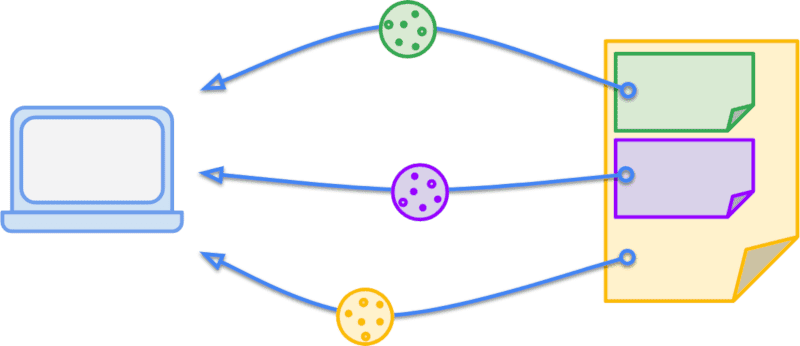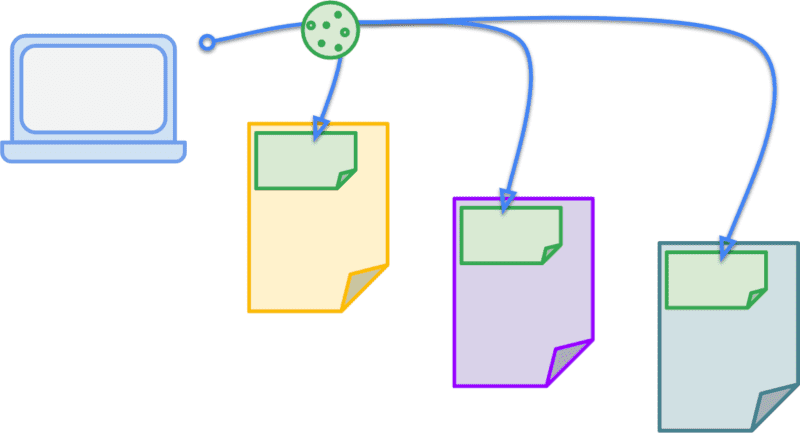A cookie is a chunk of data stored in the browser that is used to persist state and other information a website needs to execute its features.
A cookie is a small file that websites store on their user's machine, the information it stores travels back and forth between the browser and the website.
Each cookie is a key-value pair along with a number of attributes that control when and where that cookie is used. These attributes are used to set things like expiration dates or indicating the cookie should only be sent over HTTPS. You can set a cookie in an HTTP header or through JavaScript interface.
Cookies are one of the methods available for adding persistent state to web sites. Over the years their capabilities have grown and evolved, but left the platform with some problematic legacy issues. To address this, browsers (including Chrome, Firefox, and Edge) are changing their behavior to enforce more privacy-preserving defaults.
Cookies in action
Say you have a blog where you want to display a "What's new" promo to your users. Users can dismiss the promo and then they won't see it again for a while. You can store that preference in a cookie, set it to expire in a month (2,600,000 seconds), and only send it over HTTPS. That header would look like this:
Set-Cookie: promo_shown=1; Max-Age=2600000; Secure

Set-Cookie header.
When your reader views a page that meets those requirements—they're on a secure connection and the cookie is less than a month old—their browser will send this header in its request:
Cookie: promo_shown=1

Cookie header.
You can also add and read the cookies available to that site in JavaScript using
document.cookie. Making an assignment to document.cookie will create or
override a cookie with that key. For example, you can try the following in your
browser's JavaScript console:
→ document.cookie = "promo_shown=1; Max-Age=2600000; Secure"
← "promo_shown=1; Max-Age=2600000; Secure"
Reading document.cookie will output all the cookies accessible in the current
context, with each cookie separated by a semicolon:
→ document.cookie;
← "promo_shown=1; color_theme=peachpuff; sidebar_loc=left"

document.cookie.
If you try this on a selection of popular sites you will notice that most of
them set significantly more than just three cookies. In most cases, those
cookies are sent on every single request to that domain, which has a number of
implications. Upload bandwidth is often more restricted than download for your
users, so that overhead on all outbound requests is adding a delay on your time
to first byte. Be conservative in the number and size of cookies you set. Make
use of the Max-Age attribute to help ensure that cookies don't hang around
longer than needed.
What are first-party and third-party cookies?
If you go back to that same selection of sites you were looking at before, you probably noticed that there were cookies present for a variety of domains, not just the one you were currently visiting. Cookies that match the domain of the current site, that is, what's displayed in the browser's address bar, are referred to as first-party cookies. Similarly, cookies from domains other than the current site are referred to as third-party cookies. This isn't an absolute label but is relative to the user's context; the same cookie can be either first-party or third-party depending on which site the user is on at the time.

Continuing the earlier example, let's say one of your blog posts has a
picture of a particularly amazing cat in it and it's hosted at
/blog/img/amazing-cat.png. Because it's such an amazing image, another person
uses it directly on their site. If a visitor has been to your blog and has the
promo_shown cookie, then when they view amazing-cat.png on the other
person's site that cookie will be sent in that request for the image. This
isn't particularly useful for anyone since promo_shown isn't used for anything
on this other person's site, it's just adding overhead to the request.
If that's an unintended effect, why would you want to do this? It's this mechanism that allows sites to maintain state when they are being used in a third-party context. For example, if you embed a YouTube video on your site then visitors will see a "Watch later" option in the player. If your visitor is already signed in to YouTube, that session is being made available in the embedded player by a third-party cookie—meaning that "Watch later" button will just save the video in one go rather than prompting them to sign in or having to navigate them away from your page and back over to YouTube.

One of the cultural properties of the web is that it's tended to be open by
default. This is part of what has made it possible for so many people to create
their own content and apps there. However, this has also brought a number of
security and privacy concerns. Cross-site request forgery (CSRF) attacks rely on
the fact that cookies are attached to any request to a given origin, no matter
who initiates the request. For example, if you visit evil.example then it can
trigger requests to your-blog.example, and your browser will happily attach
the associated cookies. If your blog isn't careful with how it validates those
requests then evil.example could trigger actions like deleting posts or adding
their own content.
Users are also becoming more aware of how cookies can be used to track their
activity across multiple sites. However until now there hasn't been a way to
explicitly state your intent with the cookie. Your promo_shown cookie should
only be sent in a first-party context, whereas a session cookie for a widget
meant to be embedded on other sites is intentionally there for providing the
signed-in state in a third-party context.
You can explicitly state your intent with a cookie by setting the appropriate SameSite attribute.
To identify your first-party cookies and set appropriate attributes, check out First-party cookie recipes.

